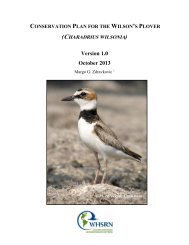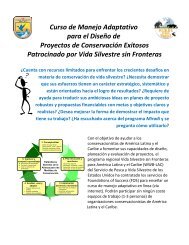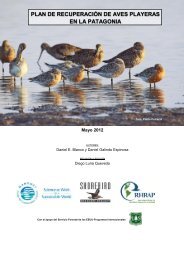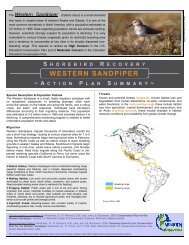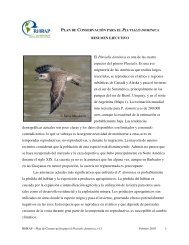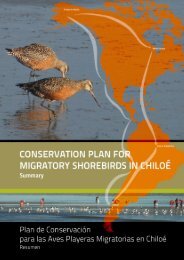Sanderling Plan - Western Hemisphere Shorebird Reserve Network
Sanderling Plan - Western Hemisphere Shorebird Reserve Network
Sanderling Plan - Western Hemisphere Shorebird Reserve Network
You also want an ePaper? Increase the reach of your titles
YUMPU automatically turns print PDFs into web optimized ePapers that Google loves.
PURPOSE<br />
This document focuses on the <strong>Sanderling</strong> in the Americas, especially North America.<br />
Future revisions will seek to include more complete information for Latin American regions as it<br />
becomes available. The present plan covers our current knowledge of <strong>Sanderling</strong> distribution,<br />
life history, and population sizes and trends. In addition, the plan describes and lists current<br />
threats and management needs, and outlines suggested conservation actions.<br />
STATUS AND NATURAL HISTORY<br />
Most of the research on <strong>Sanderling</strong>s has focused on them during the nonbreeding season,<br />
with the most extensive work being on foraging behavior, spacing, and population structure<br />
(Myers 1981, 1983b, 1984; Myers et al. 1979a, 1979b, 1981; Pitelka et al. 1980), as well as<br />
physiology on migration and the wintering grounds (Castro et al. 1989, 1992; Castro and Myers<br />
1990, 1993). More recent studies have noted apparent rapid declines in regional populations,<br />
with the apparent cause being habitat degradation and increasing recreational use of sandy<br />
beaches (MacWhirter et al. 2002).<br />
The <strong>Sanderling</strong> is the well-known, small, plump sandpiper of sandy ocean beaches, most<br />
often seen running along at the edge of incoming and receding waves. Less often, <strong>Sanderling</strong>s<br />
occur at sand/mudflats, lagoons and inland lake shores, or intertidal rocky shores. They feed on<br />
aquatic and terrestrial invertebrates, such as small crustaceans and bivalve mollusks, and less<br />
frequently on small polychaete worms, insects, and talitrid amphipods (MacWhirter et al. 2002).<br />
Although <strong>Sanderling</strong>s are North America’s most widespread maritime shorebird during winter,<br />
local numbers are usually small. Their wintering range is extraordinarily wide, spanning 100 o<br />
latitude and encompassing most temperate and tropical beaches in the Americas (MacWhirter et<br />
al. 2002). <strong>Sanderling</strong>s winter between 50 o N and 50 o S on the Pacific Coast (southern British<br />
Columbia to southern Chile), and between 42°N and 50°S on the Atlantic Coast (Massachusetts<br />
to Southern Argentina).<br />
The <strong>Sanderling</strong> breeds across the high arctic, with highest numbers occurring in the<br />
Canadian Arctic archipelago, Greenland, and high-arctic Siberia (MacWhirter et al. 2002).<br />
<strong>Sanderling</strong>s nest either as single pairs or in loose colonies, and lay four eggs in a ground nest<br />
typically situated in exposed, well-drained tundra. Eggs hatch after 23–27 days, and both sexes<br />
WHSRN – <strong>Sanderling</strong> Conservation <strong>Plan</strong>, February 2010, v1.1 9





